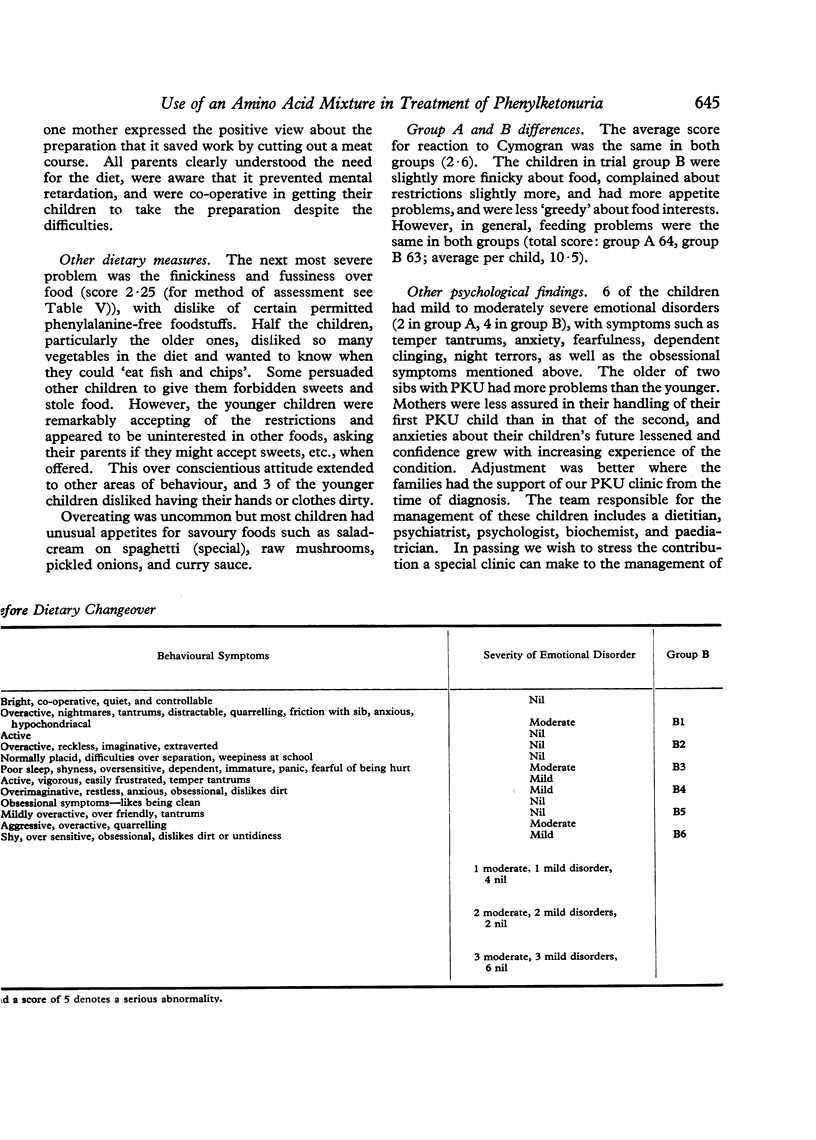Abstract
Twelve children with phenylketonuria diagnosed and treated from the first few weeks of life were grouped into pairs. Before the trial all of them were receiving a commercial preparation containing a protein hydrolysate low in phenylalanine (Cymogran, Allen and Hanburys Ltd.) as a substitute for natural protein. One of each pair was given an amino acid mixture instead of Cymogran for about 6 months. Use of the mixture involved considerable modification of the diet, and in particular the inclusion of greater amounts of phenylalanine-free foods. All six accepted the new mixture without difficulty, food problems were greatly reduced, parents welcomed the new preparation, and the quality of family life improved. Normal growth was maintained and with a mixture of l amino acids the plasma and urinary amino acid levels were normal. Further studies are needed before the mixture can be recommended for children under 20 months of age.
Full text
PDF










Selected References
These references are in PubMed. This may not be the complete list of references from this article.
- Barratt T. M., McLaine P. N., Soothill J. F. Albumin excretion as a measure of glomerular dysfunction in children. Arch Dis Child. 1970 Aug;45(242):496–501. doi: 10.1136/adc.45.242.496. [DOI] [PMC free article] [PubMed] [Google Scholar]
- Bessman S. P. Legislation and advances in medical knowledge--acceleration or inhibition? J Pediatr. 1966 Aug;69(2):334–338. doi: 10.1016/s0022-3476(66)80350-5. [DOI] [PubMed] [Google Scholar]
- Birch H. G., Tizard J. The dietary treatment of phenylketonuria: not proven? Dev Med Child Neurol. 1967 Feb;9(1):9–12. doi: 10.1111/j.1469-8749.1967.tb02203.x. [DOI] [PubMed] [Google Scholar]
- Brimblecombe F. S., Blainey J. D., Stoneman M. E., Wood B. S. Dietary and Biochemical Control of Phenylketonuria. Br Med J. 1961 Sep 23;2(5255):793–798. doi: 10.1136/bmj.2.5255.793. [DOI] [PMC free article] [PubMed] [Google Scholar]
- CLAYTON B., FRANCIS D., MONCRIEFF A. A METHOD FOR FEEDING THE PHENYLKETONURIC INFANT. Br Med J. 1965 Jan 2;1(5426):54–54. doi: 10.1136/bmj.1.5426.54. [DOI] [PMC free article] [PubMed] [Google Scholar]
- Clayton B. E., Heeley A. F., Heeley M. An investigation of the hyperaminoaciduria in phenylketonuria associated with the feeding of certain commercial low-phenylalanine preparations. Br J Nutr. 1970 Jun;24(2):573–580. doi: 10.1079/bjn19700055. [DOI] [PubMed] [Google Scholar]
- Clayton B., Moncrieff A., Roberts G. E. Dietetic treatment of phenylketonuria: a follow-up study. Br Med J. 1967 Jul 15;3(5558):133–136. doi: 10.1136/bmj.3.5558.133. [DOI] [PMC free article] [PubMed] [Google Scholar]
- Fairney A., Francis D., Ersser R. S., Seakins J. W., Cottom D. Diagnosis and treatment of tyrosinosis. Arch Dis Child. 1968 Oct;43(231):540–547. doi: 10.1136/adc.43.231.540. [DOI] [PMC free article] [PubMed] [Google Scholar]
- Fuller R. N., Shuman J. B. Phenylketonuria and intelligence: trimodal response to dietary treatment. Nature. 1969 Feb 15;221(5181):639–642. doi: 10.1038/221639a0. [DOI] [PubMed] [Google Scholar]
- Hackney I. M., Hanley W. B., Davidson W., Lindsao L. Phenylketonuria: mental development, behavior, and termination of low phenylalanine diet. J Pediatr. 1968 May;72(5):646–655. doi: 10.1016/s0022-3476(68)80007-1. [DOI] [PubMed] [Google Scholar]
- Wolff S. Behavioural characteristics of primary school children referred to a psychiatric department. Br J Psychiatry. 1967 Aug;113(501):885–893. doi: 10.1192/bjp.113.501.885. [DOI] [PubMed] [Google Scholar]
- Wood A. C., Jr, Friedman C. J., Steisel I. M. Psychosocial factors in phenylketonuria. Am J Orthopsychiatry. 1967 Jul;37(4):671–679. doi: 10.1111/j.1939-0025.1967.tb00508.x. [DOI] [PubMed] [Google Scholar]


